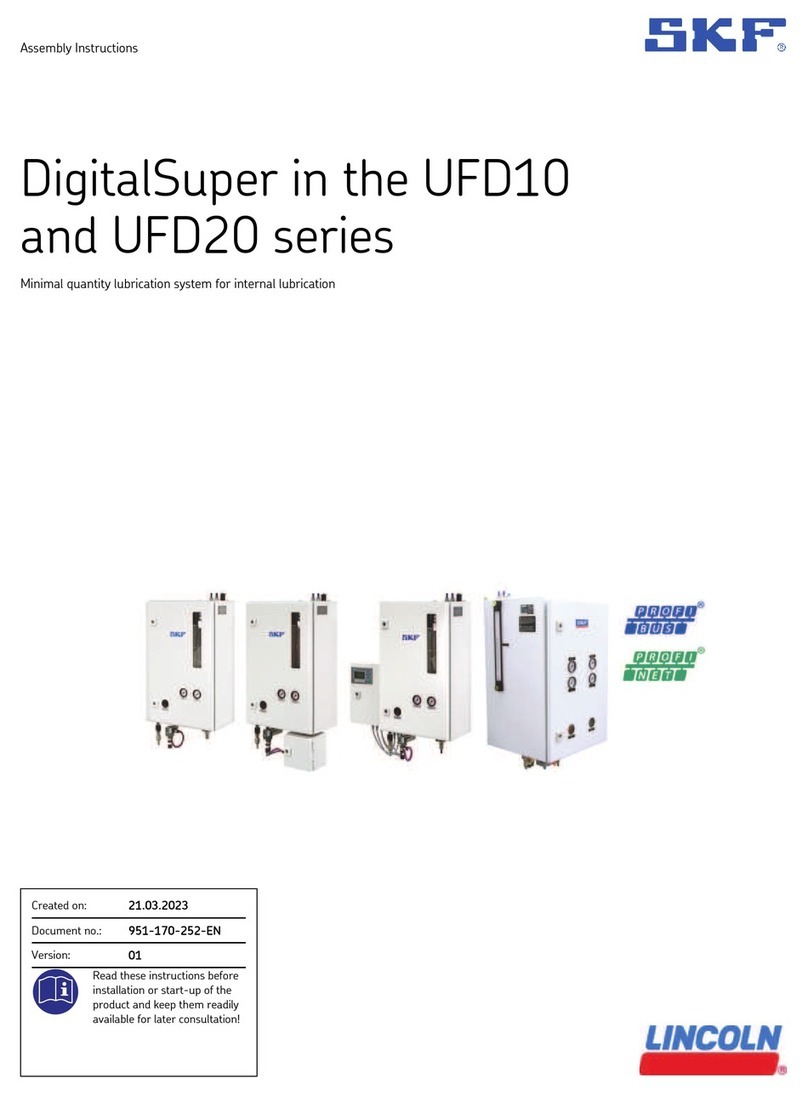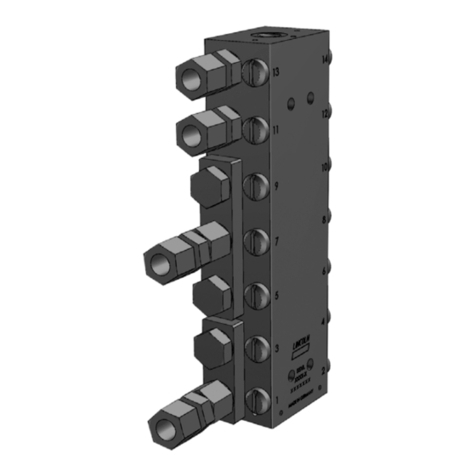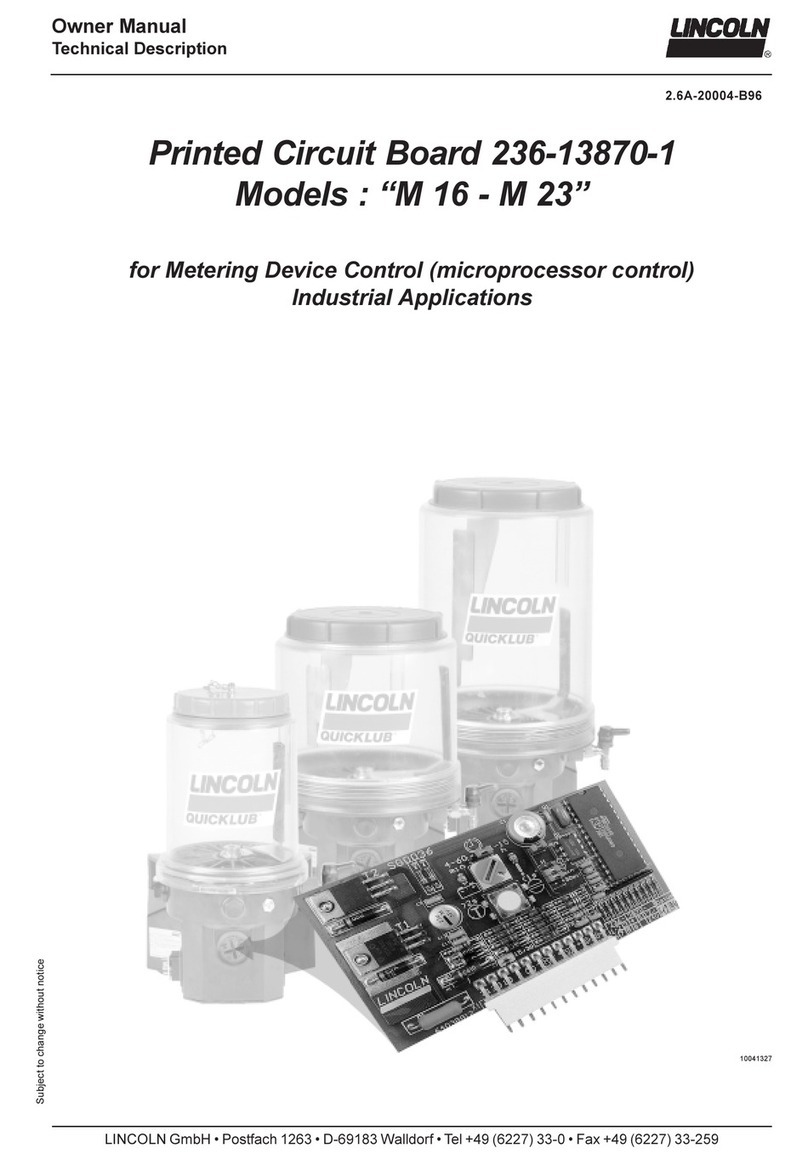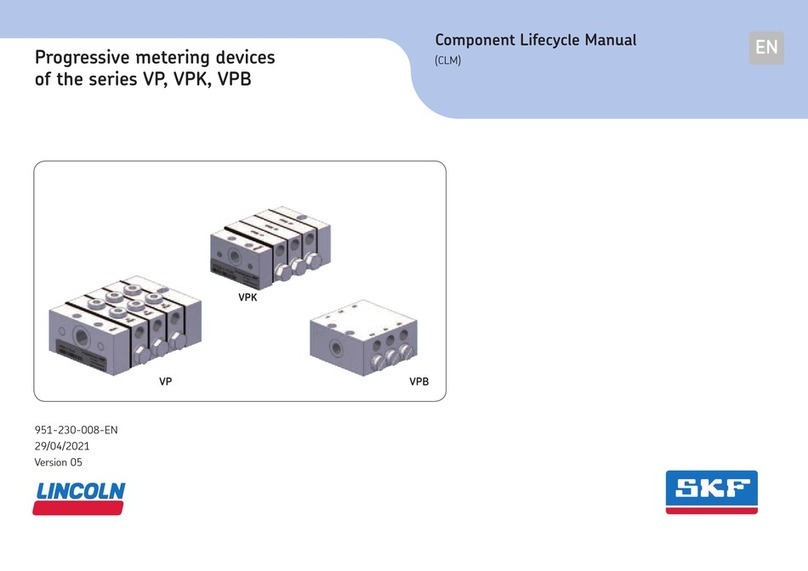Lincoln SKF VTEC User manual

Assembly Instructions
VTEC unit
SKF VectoLub
Date issue:
08-2022
Document No.:
951-130-440
Version :
02
Read manual prior to
installation or use of this
product. Keep manual nearby
for future reference.

2
Original EC Declaration of Incorporation in accordance with Directive 2006/42/EC,
Appendix II Part 1 B
The manufacturer hereby declares at its sole responsibility that the partly completed machinery conforms to the essential health and safety requirements
of the Machinery Directive 2006/42/EC, Annex I, marked in the Annex to the EC Declaration of Incorporation as applicable and fulfilled at the time of placing
on the market.
The special technical documents were prepared following Annex VII part B. Upon justifiable request, these special technical documents can be forwarded
electronically to the respective national authorities. The authorized company for the compilation of the technical documentation is the manufacturer.
Designation:
Lubrication unit, oil projection
Type:
VTEC, VE1B, USVB
Document No.:
see nameplate
Year of construction:
see nameplate
Furthermore, the following directives and standards were applied in the respective applicable areas:
2011/65/EU: RoHS II
2014/30/EU: Electromagnetic Compatibility
REACH regulation 1907/2006
EN ISO 12100:2010
EN 60204-1
EN IEC 63000
EN 809
The partly completed machinery must not be put into service until it has been established that the machinery into which it is to be incorporated is in
compliance with the provisions of the Machinery Directive 2006/42/EC and all other applicable Directives.
Saint-Cyr-sur-Loire, 20-07-2022
Laurent Aulay
Product Innovation
Manager
Manufacturer: SKF France SAS, 204 bld Charles de Gaulle, B.P. 239 FR 37540 St-Cyr-sur-Loire
Person responsible for technical file compilation: SKF France SAS, bld Charles de Gaulle, B.P. 239, 37540 St-Cyr-sur-Loire, France
Original UK Declaration of incorporation according to the Supply of Machinery (Safety)
Regulations 2008 No. 1597 Annex II
The manufacturer hereby declares under sole responsibility that the partly completed machinery complies with the essential health and safety
requirements of UK legislation Supply of Machinery (Safety) Regulations 2008 No. 1597 Annex I, marked in the Annex to the EC Declaration of
Incorporation as applicable and fulfilled at the time of placing on the market.
The special technical documents were prepared following Annex VII part B. Upon justifiable request, these special technical documents can be forwarded
electronically to the respective national authorities. The authorized company for the compilation of the technical documentation is SKF (U.K.) Limited,
2 Canada Close, Banbury, Oxfordshire, OX16 2RT, GBR.
Designation:
Lubrication unit, oil projection
Type:
VTEC, VE1B, USVB
Document No.:
see nameplate
Year of construction:
see nameplate
Furthermore, the following regulations and standards were applied in the respective applicable areas:
Supply of Machinery (Safety) Regulations 2008 No. 1597
•Electromagnetic Compatibility Ordinance 2016 No. 1091
•The Restriction of the Use of Certain Hazardous Substances in Electrical and Electronic Equipment Regulations 2012 No. 3032
EN ISO 12100:2010
EN 60204-1
EN IEC 63000
EN 809
The partly completed machinery must not be put into service until it has been established that the machinery into which it is to be incorporated is in
compliance with the provisions of UK legislation Supply of Machinery (Safety) Regulations 2008 No. 1597 and all other applicable Directives.
Saint-Cyr-sur-Loire, 20-07-2022
Laurent AULAY
Product Innovation
Manager
The manufacturer: SKF France SAS, 204 bld Charles de Gaulle, B.P. 239 FR 37540 St-Cyr-sur-Loire
Person responsible for technical file compilation: SKF (U.K.) Limited, 2 Canada Close, Banbury, Oxfordshire, OX16 2RT, GBR

3
Appendix to Declaration of Incorporation in accordance with 2006/42/EC, Annex II, No. 1 B
Description of the essential health and safety requirements according to 2006/42/EC, Annex I, which have been applied and fulfilled:
Table 1
Appendix to Declaration of Incorporation
No.:
Essential health and safety requirement
Applicable:
Fulfilled:
1.1.1
Definitions
no
1.1.2
Principles of safety integration
yes
yes
1.1.3
Materials and products
yes
Partly1)
1.1.4
Lighting
no
1.1.5
Design of machinery to facilitate its handling
yes
yes
1.1.6
Ergonomics
yes
Partly2)
1.1.7
Work place
no
1.1.8
Seat
no
1.2
Control systems
1.2.1
Safety and reliability of control systems
no
1.2.2
Control devices
no
1.2.3
Starting
no
1.2.4
Stopping
no
1.2.4.1
Normal stop
no
1.2.4.2
Operational stop
no
1.2.4.3
Emergency stop
no
1.2.4.4
Assembly of machinery
no
1.2.5
Selection of control or operating modes
no
1.2.6
Failure of the power supply
no
1.3
Protection against mechanical hazards
1.3.1
Risk of loss of stability
no
1.3.2
Risk of break-up during operation
yes
yes
1.3.3
Risks due to falling or ejected objects
no
1.3.4
Risks due to surfaces, edges or angles
yes
yes
1.3.5
Risks related to combined machinery
no
1.3.6
Risks related to variations in operating conditions
no
1.3.7
Risks related to moving parts
no
1.3.8
Choice of protection against risks arising from moving parts
no
1.3.8.1
Moving transmission parts
no
1.3.8.2
Moving parts involved in the process
no
1.3.9
Risks of uncontrolled movements
no
1.4
Required characteristics of guards and protective devices
1.4.1
General requirements
no
1.4.2
Special requirements for guards
no
1.4.2.1
Fixed guards
no
1.4.2.2
Interlocking movable guards
no
1.4.2.3
Adjustable guards restricting access
no
1.4.3
Special requirements for protective devices
no
1.5
Risks due to other hazards
1.5.1
Electricity supply
yes
yes
1.5.2
Static electricity
no
1.5.3
Energy supply other than electricity
yes
yes
1.5.4
Errors of fitting
yes
yes
1.5.5
Extreme temperatures
no
1.5.6
Fire
no
1.5.7
Explosion
no
1.5.8
Noise
yes
Partly3)
1.5.9
Vibrations
no
2010-05-01
Radiation
no
2011-05-01
External radiation
no

4
Table 1
Appendix to Declaration of Incorporation
No.:
Essential health and safety requirement
Applicable:
Fulfilled:
2012-05-01
Laser radiation
no
2013-05-01
Emissions of hazardous materials and substances
yes
Partly4)
2014-05-01
Risk of being trapped in a machine
no
2015-05-01
Risk of slipping, tripping or falling
no
2016-05-01
Lightning
yes
yes
1.6
Maintenance
1.6.1
Machinery maintenance
no
1.6.2
Access to operating positions and servicing points
yes
Partly5)
1.6.3
Isolation of energy sources
yes
Partly6)
1.6.4
Operator intervention
yes
yes
1.6.5
Cleaning of internal parts
no
1.7
Information
1.7.1
Information and warnings on the machinery
no
1.7.1.1
Information and information devices
yes
yes
1.7.1.2
Warning devices
yes
yes
1.7.2
Warning of residual risks
yes
yes
1.7.3
Marking of machinery
yes
yes
1.7.4
Instructions
yes
yes
1.7.4.1
General principles for the drafting of instructions
yes
yes
1.7.4.2
Contents of the instructions
yes
yes
1.7.4.3
Sales literature
yes
yes
1) The product is basically designed for the use of harmless media. The operator must check whether the lubricant used has certain
hazardous effects (e.g. sensitization). If necessary, a retention tray may be required.
2) The integrator has to ensure that the pump is integrated into the machine in such way that operation and filling of the pump are
ergonomically possible.
3) The acoustical level is varying and depends on many factors such as eg micropump number, the working frequency and environment.
Therefore personal protective equipment against noise must be provided to operators.
4) The operator must adjust the carrier air pressure for oil projection in order to prevent any oil mist. If the risk cannot be completely
avoided, the integrator must provide the containment of the machine to which the lubrication unit is integrated and an oil mist evacuation
device.
5) The integrator has to ensure that the pump is integrated into the machine in such way to have a quick and safe access to control and
monitoring devices of the lubrication unit.
6) The integrator must provide isolation devices for energy supply (electricity and compressed air) to the lubrication unit.

5
Imprint
In accordance with the EU Machine Directive 2006/42/CE, the
installation and operation instructions are an integral part of a
lubrication system and must be kept close to the equipment for
future reference.
The installation and operation instructions were drafted in
compliance with the applicable standards and rules governing
technical documentation.
© SKF
This documentation is protected by copyright. All rights
reserved. The photomechanical reproduction, copying, and
distribution of this documentation or parts thereof by means of
processes such as data processing, data carriers, and data
networks is strictly prohibited without the express permission of
SKF.
Subject to editorial or technical modifications.
Manufacturer
SKF France SAS
204, bld Charles de Gaulle, B.P. 239
37540 St-Cyr-sur-Loire, France
Service
For all technical questions, please contact:
SKF Lubrication Systems Germany GmbH
Email: [email protected]
Berlin Plant
Motzener Straße 35/37
12277 Berlin
Germany
Tel. +49 (0)30 72002-0
Fax +49 (0)30 72002-111
Walldorf Plant
Heinrich-Hertz-Straße 2-8
69190 Walldorf
Germany
Tel. +49 (0) 6227 33-0
Fax +49 (0) 6227 33-259
Or an SKF Service Center, the addresses of which are given
on our website:
www.skf.com/lubrication
Training courses
In order to provide a maximum of safety and economic viability,
SKF carries out detailed training courses. It is recommended
that the training courses are attended. For more information
please contact the SKF Service Center or the local SKF
representative.
Warranty
The manual does not contain any information on the warranty.
This can be found in our General Conditions of Sales. The
General Conditions of Sales are available on the SKF Group
website at: www.skf.com
Disclaimer
The manufacturer shall not be held responsible for damages
caused by:
•non appropriate use, faulty assembly, operation, setting,
maintenance, repair or accidents
• use of inappropriate lubricants
• improper response to malfunctions
• unauthorized modifications of the product
• intent or negligence
• use of non-original SKF spare parts;
• improper planning or design of a centralized lubrication
system.
Liability for loss or damage resulting from the use of our
products is limited to the maximum purchase price. Liability for
consequential damages of whatever kind is excluded.
Authorized local distributors
- Great Britain -
SKF (U.K.) Limited,
2 Canada Close, Banbury, Oxfordshire,
OX16 2RT, GBR.
- North America -
SKF Lubrication Business Unit
Lincoln Industrial
5148 North Hanley Road, St. Louis,
MO. 63134 USA
- South America -
SKF Argentina Pte. Roca 4145,
CP 2001 Rosario, Santa Fe

6
Table of contents
Imprint ................................................................................................5
Manufacturer......................................................................................5
Service ................................................................................................5
Training courses.................................................................................5
Warranty .............................................................................................5
Disclaimer............................................................................................5
Table of contents................................................................................6
Safety alerts, visual presentation, and layout................................7
1. Safety instructions.........................................................................8
1.1 General safety instructions ................................................... 8
1.2 General electrical safety instructions................................... 8
1.3 General behaviour when handling the product.................. 8
1.4 Intended use............................................................................ 8
1.5 Persons authorized to use the product............................... 8
1.6 Foreseeable misuse................................................................ 9
1.7 Referenced documents.......................................................... 9
1.8 Prohibition of certain activities ............................................. 9
1.9 Painting plastic components and seals ............................... 9
1.10 Safety markings on the product ........................................ 9
1.11 Note on the type plate......................................................... 9
1.12 Notes on CE marking........................................................... 9
1.13 Note on UKCA marking ....................................................... 9
1.14 Note on China RoHS mark.................................................. 9
1.15 Assembly, maintenance, fault, repair..............................10
1.16 First start-up, daily start-up ............................................10
2. Lubricants.................................................................................... 11
2.1 General information............................................................. 11
2.2 Material compatibility...........................................................11
2.3 Temperature characteristics...............................................11
2.4 Ageing of lubricants..............................................................11
2.5 Avoidance of malfunctions and hazards............................11
3. Overview, functional description............................................... 12
3.1 Description............................................................................. 12
3.1.1 General....................................................................... 12
3.1.2 Construction.............................................................. 12
3.2 Function................................................................................. 15
4. Technical data ............................................................................. 16
5. Delivery, returns, storage.......................................................... 18
5.1 Delivery..................................................................................18
5.2 Return shipment................................................................... 18
5.3 Storage .................................................................................. 18
5.4 Storage temperature range................................................18
6. Assembly...................................................................................... 19
6.1 General................................................................................... 19
6.2 Positioning and installation.................................................19
6.2.1 Setup..........................................................................19
6.2.2 Assembly....................................................................19
6.3 Inlet connection .................................................................... 20
6.3.1 Lubricant inlet connection.......................................20
6.3.2 Pneumatic connection .............................................20
6.4 Outlet connection ................................................................. 21
6.4.1 Connection coaxial line / outlet port ......................21
6.4.2 Connection of the coaxial line to the projection
block...................................................................................... 21
6.5 Electrical connection ............................................................ 22
6.5.1 Solenoid valve ........................................................... 22
6.5.2 Pressure switch ........................................................ 23
6.6 Carrier air pressure regulator ............................................ 23
7. First start-up............................................................................... 24
7.1 Inspections prior to commissioning ................................... 24
7.2 Bleeding and commissioning .............................................. 24
7.2.1 Commissioning.......................................................... 24
7.2.2 Bleeding..................................................................... 25
7.2.3 Switching out a nozzle............................................. 25
7.3 Micropump flow rate adjustment....................................... 25
7.3.1 Adjustment with thumb wheel ............................... 25
7.3.2 Adjustment with metering ring .............................. 25
7.3.3 Neutralizing the micropump delivery .................... 26
7.4 pneumatic impulse generator ............................................ 26
8. Operation..................................................................................... 27
9. Maintenance and repair............................................................. 28
10. Cleaning..................................................................................... 28
10.1 Basics................................................................................... 28
10.2 Interior cleaning................................................................. 28
10.3 Exterior cleaning ................................................................ 28
11. Faults, causes, and remedies ................................................. 29
12. Shutdown, disposal.................................................................. 31
12.1 Temporary shutdown........................................................ 31
12.2 Permanent shutdown, disassembly ................................ 31
12.3 Disposal ............................................................................... 31
13. Spare parts ............................................................................... 32
14. Appendix.................................................................................... 35
14.1 China RoHS Table.............................................................. 35

7
Safety alerts, visual
presentation, and layout
While reading these instructions, you will encounter various
symbols, illustrations, and text layouts intended to help you
navigate and understand the instructions. Their meaning is
explained below.
Safety alerts:
Activities that present specific hazards (to life and limb or
possible damage to property) are indicated by safety alerts.
Always be sure to follow the instructions given in the safety
alerts.
<
DANGER
These safety alerts indicate an imminent danger.
Ignoring them will result in death or serious injury
<
WARNING
These safety alerts indicate potentially imminent
danger. Ignoring them could result in death or
serious injury
<
CAUTION
These safety alerts indicate potentially imminent
danger. Ignoring them could result in minor injury
<
NOTICE
These safety alerts indicate a potentially harmful
situation. Ignoring them could result in damage to
property or
malfunctions
Illustrations:
The illustrations used depict a specific product. For other
products, they may have the function of a diagram only. This
does not alter the basic workings and operation of the product.
Text layout:
•First-order bulleted lists: Items on a bulleted list start with
a solid black dot and an indent.
–Second-order bulleted lists: If there is a further listing of
subitems, the second-order bulleted list is used.
1 Legend: A legend explains the numbered contents of an
illustration, presented as a numbered list. Items in a legend
start with a number (with no dot) and an indent.
–Second-order legend: In some cases, the numbered
contents of an image represent more than just one object.
A second-order legend is then used.
1.Instruction steps: These indicate a chronological sequence
of instruction steps. The numbers of the steps are in bold and
are followed by a period. If a new activity follows, the
numbering starts again at “1.”
–Second-order instruction steps: In some cases, it is
necessary to divide up a step into a few substeps. A
sequence of second-order instruction steps is then used.

8
1. Safety instructions
1.1 General safety instructions
•Putting the products into operation or operating them without
having read the instructions is prohibited. The operator must
ensure that the instructions are read and understood by all
persons tasked with working on the product or who supervise
or instruct such persons. Retain the instructions for further
use.
•The product may only be used in awareness of the potential
dangers, in proper technical condition, and according to the
information in this manual.
•Any faults that could affect safety must be remedied
according to responsibility. The supervisor must be notified
immediately in case of malfunctions outside one's individual
scope of responsibility.
•Unauthorized modifications and changes can have an
unpredictable effect on safety and operation. Unauthorized
modifications and changes are therefore prohibited. Only
original SKF spare parts and SKF accessories may be used.
•Any unclear points regarding proper condition or correct
assembly/operation must be clarified. Operation is prohibited
until issues have been clarified.
•The components used must be suitable for the intended use
and the applicable operating conditions, e.g. max. operating
pressure and ambient temperature range, and must not be
subjected to torsion, shear, or bending.
1.2 General electrical safety instructions
•Electrical devices must be kept in proper condition. This must
be ensured by periodic inspections in accordance with the
relevant applicable standards and technical rules. The type,
frequency, and scope of the inspections must be determined
in accordance with the risk assessment to be carried out by
the operator. Work on electrical components may be
performed only by qualified electricians. Connect the electrical
power only in accordance with the valid terminal diagram and
in observance of the relevant regulations and the local
electrical supply conditions.
•Work on electrical components may be performed only in a
voltage-free state and using tools suitable for electrical work.
Do not touch cables or electrical components with wet or
moist hands.
•Fuses must not be bridged. Always replace defective fuses
with fuses of the same type.
•Ensure proper connection of the protective conductor for
products with protection class I. Observe the specified
enclosure rating.
•The operator must implement appropriate measures to
protect vulnerable electrical devices from the effects of
lightning during use. The electrical device is not furnished
with a grounding system for the dissipation of the respective
electric charge and does not have the voltage strength
necessary to withstand the effects of lightning.
1.3 General behaviour when handling the
product
•Familiarize yourself with the functions and operation of the
product. The specified assembly and operating steps and their
sequences must be observed.
•Keep unauthorized persons away.
•Wear personal protective equipment always.
•Precautionary operational measures and instructions for the
respective work must be observed.
•In addition to these Instructions, general statutory regulations
for accident prevention and environmental protection must be
observed.
•Precautionary operational measures and instructions for the
respective work must be observed. Uncertainty seriously
endangers safety.
•Safety-related protective and safety equipment must not be
removed, modified or affected otherwise in its function and is
to be checked at regular intervals for completeness and
function.
•If protective and safety equipment has to be dismantled, it
must be reassembled immediately after finishing the work,
and then checked for correct function.
•Remedy occurring faults in the frame of responsibilities.
Immediately inform your superior in the case of faults beyond
your competence.
•Never use parts of the centralized lubrication system or of the
machine as standing or climbing aids.
1.4 Intended use
Supply of lubricants.
Supply of lubricant to lubrication points.
Spare parts should only be used to replace faulty components
of identical construction.
Use is only permitted within the scope of commercial or
economic activity by professional users, in compliance with the
specifications, technical data, and limits specified in this manual.
1.5 Persons authorized to use the
product
Operator
A person who is qualified by training, knowledge and experience
to carry out the functions and activities related to normal
operation. This includes avoiding possible hazards that may
arise during operation.
Specialist in electrics
Person with appropriate professional education, knowledge and
experience to detect and avoid the hazards that may arise from
electricity.
Specialist in mechanics
Person with appropriate professional education, knowledge and
experience to detect and avoid the hazards that may arise
during transport, installation, start-up, operation, maintenance,
repair and disassembly.

9
1.6 Foreseeable misuse
Any usage of the product other than as specified in this manual
is strictly prohibited. Particularly prohibited are:
•Use of non-specified consumables, contaminated lubricants,
or lubricants with air inclusions.
•Use of C3 versions in areas with aggressive, corrosive
substances (e.g., high salt load).
•Use of plastic parts in areas with high exposure to ozone, UV
light, or ionizing radiation.
•Use to supply, convey, or store hazardous substances and
mixtures as defined in the CLP Regulation (EC 1272/2008) or
GHS with acute oral, dermal, or inhalation toxicity or
substances and mixtures that are marked with hazard
pictograms GHS01-GHS06 and GHS08.
•Use to supply, convey, or store Group 1 fluids classified as
hazards as defined in the Pressure Equipment Directive
(2014/68/EU) Article 13 (1) a).
•Use to supply, convey, or store gases, liquefied gases,
dissolved gases, vapors, or fluids whose vapor pressure
exceeds normal atmospheric pressure (1013 mbar) by more
than 0.5 bar at their maximum permissible operating
temperature.
•Use in an explosion protection zone.
•Use without proper securing against excessively high
pressures, in the case of pressurized products.
•Use outside of the technical data and limits specified in this
manual.
1.7 Referenced documents
In addition to this manual, the following documents must be
observed by the respective target group:
•Company instructions and approval rules
If applicable:
•Safety data sheet of the lubricant used
•Project planning documents
•Supplementary information regarding special designs of the
pump. This you will find in the special system documentation.
•Instructions for other components for setting up the
centralized lubrication system.
In addition to this manual, the following documents must be
observed by the respective target group:
•Company instructions and approval rules
If applicable:
•Safety data sheet of the lubricant used
•Project planning documents
•Supplementary information regarding special designs of the
pump. This you will find in the special system documentation.
•Instructions for other components for setting up the
centralized lubrication system.
1.8 Prohibition of certain activities
•Replacement of or modifications to the pistons of the pump
elements
•Repairs or modifications to the drive
•Alterations to the control circuit board beyond adjustment of
lubrication times and interval times or replacement in case of
defect
•Alterations to the power supply board beyond replacement in
case of defect
1.9 Painting plastic components and
seals
The painting of any plastic components and seals of the
products described is prohibited. Completely mask or remove
plastic components before painting the main machine.
1.10 Safety markings on the product
No safety markings on the product
NOTE
In accordance with the results of the workstation risk
assessment, additional labels (e.g., warnings, safety signs,
prohibition signs, or labels in accordance with CLP/GHS) are
to be attached by the operator if necessary.
1.11 Note on the type plate
The type plate provides important data such as the type
designation, order number, and sometimes regulatory
characteristics. To avoid loss of this data in case the type plate
becomes illegible, it should be entered in the manual.
1.12 Notes on CE marking
CE marking is effected following the requirements
of the applied directives requiring a CE marking:
•2014/30/EC Electromagnetic Compatibility
•2011/65/EU Directive on the restriction of the use of certain
hazardous substances in electrical and electronic equipment
(RoHS II)
1.13 Note on UKCA marking
The UKCA conformity marking confirms the
product’s conformity with the applicable legal
provisions of Great Britain.
1.14 Note on China RoHS mark
The China RoHS mark confirms that there is no
danger to persons or the environment from the
regulated substances contained within for the
intended period of use (year number shown in the
circle).

10
1.15 Assembly, maintenance, fault,
repair
Prior to the start of this work, all relevant persons must be
notified of it. At a minimum, the following safety measures must
be taken before any work is done:
•Unauthorized persons must be kept away
•Mark and secure the work area
•Cover adjacent live parts
•Dry any wet, slippery surfaces or cover them appropriately
•Cover hot or cold surfaces appropriately
Where applicable:
•Depressurize
•Isolate, lock and tag out
•Check to ensure live voltage is no longer present
•Ground and short-circuit
The product should be protected as much as possible from
humidity, dust, and vibration, and should be installed so that it
is easily accessible. Ensure an adequate distance from sources
of heat or cold. Any visual monitoring devices present, such as
pressure gauges, min./max. markings, or oil level gauges must
be clearly visible. Observe the mounting position requirements.
Drill required holes only on non-critical, non-load-bearing
parts of the operator's infrastructure. Use existing holes where
possible. Avoid chafe points. Immobilize any moving or detached
parts during the work. Adhere to the specified torques.
If guards or safety devices need to be removed, they must be
reinstalled immediately following conclusion of work and then
checked for proper function.
Check new parts for compliance with the intended use before
using them.
Avoid mixing up or incorrectly assembling disassembled parts.
Label parts. Clean any dirty parts.
1.16 First start-up, daily start-up
Ensure that:
•All safety devices are fully present and functional
•All connections are properly connected
•All parts are correctly installed
•All warning labels on the product are fully present, visible, and
undamaged
•Illegible or missing warning labels are immediately replaced

11
2. Lubricants
2.1 General information
Lubricants are selected specifically for the respective
application. The selection is made by the manufacturer or
operator of the machine, preferably together with the lubricant
supplier. Should you have little or no experience with the
selection of lubricants for lubrication systems, please contact us.
We will be pleased to support you in the selection of suitable
lubricants and components for the construction of a lubrication
system optimized for the respective application. Please observe
the following points when selecting/using lubricants. You will
avoid possible downtimes and damages to your machine or the
lubrication system.
2.2 Material compatibility
Lubricants must generally be compatible with the following
materials:
•Plastics: ABS, CR, FPM, NBR, NR, PA, PET, PMMA, POM, PP,
PS, PTFE, PU, PUR
Metal steel, grey iron, brass, copper, aluminium
2.3 Temperature characteristics
The lubricant used must be suitable for the specific ambient
temperature of the product. The viscosity required for proper
operation of the product must not be exceeded in case of low
temperatures nor fall below specification in case of high
temperatures. Specified viscosity, see chapter Technical data.
2.4 Ageing of lubricants
Depending on the experience with the lubricant used, it should
be checked at regular intervals to be determined by the
operator whether the lubricant needs to be replaced due to
ageing processes (bleeding). If there is any doubt as to the
further suitability of the lubricant, it must be replaced before
recommissioning. If you have no experience with the lubricant
used, we recommend testing after only one week.
2.5 Avoidance of malfunctions and
hazards
To avoid malfunctions or hazards, please observe the following:
•When handling lubricants, observe the relevant safety data
sheets (SDS) and hazard designations on the packaging, if
any.
•Due to the large number of additives, individual lubricants
which meet the requirements for pumpability specified in the
instructions may not be suitable for use in centralized
lubrication systems.
•Always use SKF lubrication greases, if possible. These are
optimally suited for use in lubrication systems.
•Do not mix lubricants. This may have unforeseeable effects
on the characteristics and on the usability of the lubricant.
•The ignition temperature of the lubricant must lie at least
50 K over the maximum surface temperature of the
components.

12
3. Overview, functional
description
3.1 Description
3.1.1 General
The VTEC unit is a modular unit made up of one to eight
different modules. Each module allows lubrication of a
lubrication point using a micropump.
The VTEC unit can jointly or independently control and
monitor the lubrication of several lubrication points. The user
can therefore manage different independent lubrication circuits
with a single unit.
The modular nature of the VTEC unit makes it possible to:
•Lubricate 1 to 8 lubrication points with a single unit
•Individually adjust the flow rate of a micropump
corresponding to a lubrication point
•Adjust the lubrication frequency for a single lubrication point
or multiple lubrication points together
•Adjust the carrier air flow independently for each lubrication
point
•Visually (pressure gauge) or electrically (pressure switch)
monitor the carrier air pressure individually for each
lubrication point
3.1.2 Construction
Figure 1shows one of the VTEC unit model made up of eight
modules.
Legend figure 1
1 pressure switch, carrier air monitoring
2 General air solenoid valve
3 oil inlet
4 air inlet port (module with a general air solenoid valve)
5 Pneumatic impulse generator
6 Bare base (slave)
7 Micropump control solenoid valve
8 Micropump (setting with metering ring)
9 carrier air pressure regulator
10 pressure gauge, general air monitoring
11 coaxial outlet port (air and oil)
12 pressure gauge, carrier air monitoring
This is a front side view with the compressed air and oil inlets
on the left side.
The unit has one oil inlet with quick-release connector, and
two compressed air inlets with quick-release connector. But
only one air inlet port is used, the other being closed with a
screw plug. The lower air inlet port is used when the first
module has a “i” base (with a general air solenoid valve). The
upper inlet port is used with every other bases.
Except the “I” base, with the general air solenoid valve, all
other bases work in the same way.
Every module has on the top an outlet port for coaxial hose
air and lubricant with two quick-release connectors. The quick-
release connector for the capillary tube (lubricant) is located
beneath the quick-release connector for the outer tube (air).
The user can set the carrier air pressure with a pressure
regulator. The air flow can be monitored either with a pressure
gauge or with a pressure switch.
A pneumatic micropump is mounted under every module.
The user can adjust the flow rate of the pump with metering
rings or with a thumb wheel.
A module can have up to two different additional equipment
on the front side:
•a pneumatic impulse generator to adjust the delivery
frequency of the micropump
•an air solenoid valve to control the air inlet for the pneumatic
micropump.
Every module can have one or two of the equipment.
According to the equipment a module is “slave” or “master”.

13
Fig. 1
VTEC unit
1
2
3
4
12 11 10 9
5 8
76

14
VTEC unit function
(→ fig. 1)
•Unit for two independent lubrication circuits, the first with
three lubrication points, the second also with three points
•Start-up is independent for the two circuits by general air
solenoid valves
•For the first circuit, the operator can manage a pause phase
and a lubrication phase with the control air solenoid valve,
and then manage the beat frequency of the micropumps
during the lubrication phase with the pneumatic frequency
generator.
•For the second circuit, the operator manages the beat
frequency of the micropumps with the control air solenoid
valve (an activation of the solenoid valve corresponds to a
beat of the micropump)
•The operator monitors the general pneumatic pressure of the
first circuit with a pressure switch (set at 5 bar), and of the
second circuit with a pressure gauge
•The operator can monitor the carrier air pressure for each
module
•The flow rate of each micropump goes from 10 to 30
mm3/stroke, with range adjustment by ring
VTEC unit module description
–1st module: general air solenoid valve, pneumatic pressure
control with pressure switch
–2nd module: control air solenoid valve and pneumatic
frequency generator, low flow rate micropump with flow
rate adjustment by ring, control of carrier air pressure by
pressure gauge
–3rd and 4th modules: without frequency control, low flow
rate micropump with flow rate adjustment by ring, control
of carrier air pressure by pressure gauge
–5th module: general air solenoid valve, pneumatic pressure
control with pressure gauge
–6th module: control air solenoid valve, low flow rate
micropump with flow rate adjustment by ring, control of
carrier air pressure by pressure gauge
–7th and 8th modules: without frequency control, low flow
rate micropump with flow rate adjustment by ring, control
of carrier air pressure by pressure gauge
–The voltage key should be +924 (24 VDC) due to the
presence of the pressure switch
Fig. 2
Schematic diagram VTEC unit
SP
1 1 1 1 1 1
P Z P Z P Z P Z P Z P Z

15
3.2 Function
When the VTEC unit is switched on, it is supplied with
compressed air (5 to 8 bar) and with lubricant (0,1 to 0,5 bar).
The oil flows through the different bases to the volumetric
pneumatic micropump. The delivery frequency of the
micropump (max. 3 stroke/s) is independently adjusted with
either a pneumatic impulse generator or a solenoid valve, which
is controlled via a control unit. The flow rate of the micropump
can be adjusted with metering rings or with a thumb wheel.
The micropump delivers a metered quantity of oil, which goes
through inner channel of the base to the coaxial outlet port.
The compressed air also flows through the different bases
and is divided in two ways in each of them. Some compressed
air is supplied to the micropump to actuate it. The other part of
the compressed air (called carrier air) is supplied to the coaxial
outlet port and goes through the outer tube of the hose. The
carrier air pressure of every base can be adjusted with a
pressure regulator. This pressure can be also monitored by
means of a pressure gauge or a pressure switch.
The low-pressure carrier air and oil are simultaneously
transported under pressure via the coaxial hose to the nozzle.
The carrier air is swirled in the nozzle. As a result, the metered
quantity of oil is broken down into microdroplets, which are
transported by the carrier air to the friction point without
causing any mist. The microdroplet size (200/600 m) ensures
a perfect oil coating without atomization.
Example of a lubrication system with VTEC unit
Legend figure 3
1 Oil reservoir
2 Pneumatic inlet
3 VTEC unit
4 Coaxial line
5 Bifluid nozzle
Fig. 3
VTEC system example
5
4
3
2
1

16
4. Technical data
Table 2
Technical data
VTEC system
VTEC unit
Number of outlets
1 to 8
Min. air inlet
800 Nl/min, dry and filtered air (5 m)
Air inlet pressure
5 to 8 bar
Micropump flow rate
3, 5, 10, 15, 20 and 30 mm3/stroke (small flow, metering rings)
7 to 30 mm3/ stroke (small flow, thumb wheel)
30, 45, 60, and 90 mm3/stroke (large flow, metering rings)
30 to 90 mm3/ stroke (large flow, thumb wheel)
Max. pump working frequency
3 strokes/s
Lubricant
mineral or synthetic oils, biodegradable oils
Eff. viscosity (at operating temperature)
10 to 400 mm2/s
Operating temperature
10 to 50 °C
Audible emissions
Cat. A (≤ 70 dB)
Fixing rail
EN 50035 or EN 50022
General air solenoid valve
Delivery rate (at 6 bar)
1 100 Nl/min
Power supply
115 V – 50/60 Hz – 2,1 VA or 230 V – 50/60 Hz – 2,1 VA or 24 V – 1,8 W
Protection
IP 65
Mechanical life
1,5× 107switching operations
É
Air solenoid valve (micropump control)
Delivery rate (at 6 bar)
150 Nl/min
Power supply
115 V – 50/60 Hz – 2,5 VA or 230 V – 50/60 Hz – 2,5 VA or 24 V – 1 W
Protection
IP 65
Mechanical life
1,5× 107switching operations
pneumatic impulse generator
Delivery rate (at 6 bar)
170 Nl/min
Mechanical life
1× 107switching operations
Frequency
0.04 to 3 Hz
Pressure switch
Switching capacity
100 VA
Protection
IP65
Voltage max.
42 V
Mechanical life
1× 106switching operations

17
Fig. 4
VTEC unit dimensions
42 30
330
204
180

18
5. Delivery, returns, storage
5.1 Delivery
After receipt of the shipment, it must be inspected for any
shipping damage and for completeness according to the
shipping documents. Immediately inform the transport carrier
of any shipping damage. The packaging material must be
preserved until any discrepancies are resolved.
5.2 Return shipment
Before return shipment, all contaminated parts must be
cleaned. If this is not possible or practical, e.g. if it would impede
fault detection in the case of complaints, the medium used must
always be specified. In the case of products contaminated with
hazardous substances as defined by GHS or CLP regulations,
the safety data sheet (SDS) must be sent with the product and
the packaging must be labelled in accordance with GHS/CLP.
There are no restrictions for land, air, or sea transport. The
choice of packaging should be based on the specific product and
the stresses to be expected during transport (e.g., necessary
anti-corrosion measures in the case of shipment by sea). In the
case of wooden packaging, the applicable import regulations
and the IPPC standards must be observed. Required certificates
must be included in the shipping documents. The following
information, as a minimum, must be marked on the packaging
of return shipments.
Fig. 5
Marking of return shipments
5.3 Storage
The following conditions apply to storage:
•Dry, low-dust, vibration-free, in closed rooms
•No corrosive, aggressive substances at the storage location
(e.g., UV rays, ozone)
•Protected against animals (insects, rodents)
•If possible, keep in the original product packaging
•Protected from nearby sources of heat or cold
•In the case of large temperature fluctuations or high humidity,
take appropriate measures (e.g. heating) to prevent the
condensation of water
•Before usage, check products for damage that may have
occurred during storage. This applies in particular to parts
made of plastic (due to embrittlement).
5.4 Storage temperature range
For parts not filled with lubricant, the permitted storage
temperature is the same as the permitted ambient temperature
range (see “Technical data”).

19
6. Assembly
<
CAUTION
System part list
Check the integrity of the delivery before starting
installation works.
6.1 General
The product described in the mounting instructions may only
be installed, operated, maintained, and repaired by qualified
experts. Qualified experts are persons who have been trained,
instructed, and familiarized with the end product into which the
described product is installed. These persons are considered
capable of such tasks due to their education, training, and
experience with valid standards, conditions, accident prevention
regulations in effect, and installation conditions. They should be
able to carry out the required tasks and to recognize – and thus
avoid – any dangers that might otherwise occur.
Before installing/positioning the product, remove the
packaging material and any transportation safety devices such
as sealing plugs. Keep packaging material until any possible
problems have been clarified.
6.2 Positioning and installation
6.2.1 Setup
The unit must be mounted in a way that protects it from
humidity and vibrations. It should also be easily accessible so
that all other installation work can be carried out without
hindrance. Ensure that there is sufficient circulating air to
prevent the system from overheating. Data on maximal
admissible ambient temperature are given in the technical data
(→ chapter 4. ).
An oil mist extraction system must be installed close to the
lubrication nozzles.
CAUTION
Oil mist
A wrong setting of the carrier air pressure
(→
chapter 7. ) may produce oil mist. The
operator must install an oil mist extraction device
at the location of the lubrication nozzles.
6.2.2 Assembly
The VTEC unit us delivered free to be mounted against a wall
with a standard rail and clips on the backside (→ fig. 6).
Fig. 6
VTEC unit mounting rail
Table 3
Mounting rail dimensions
Part number
Max. module
number
L × H × P
[mm]
L ×
<Content>
SY.9663.300
2
105 × 35 × 15
SY.9663.180
4
180 × 35 × 15
SY.9663.330
8
330 × 35 × 15
P
1,5 13
88
13
L
H
=
6,5
=

20
6.3 Inlet connection
The oil and compressed air inlet lines are connected to a VTEC
unit on the first module (left side when unit seen from the front
side as on figure 1), which has two quick-release connectors.
Fig. 7
VTEC unit inlets
1 oil inlet
2 air inlet (base with general air solenoid valve)
3 air inlet (other bases)
6.3.1 Lubricant inlet connection
Oil is supplied to the VTEC unit form an overhead reservoir.
The reservoir is connected to the VTEC unit with a Ø8 hose
and a quick connector (→ pos. 1 fig. 7).
1.Insert the hose into the quick-release coupling until stop
2.Pull carefully on the hose to check it is correctly held by the
coupling.
6.3.2 Pneumatic connection
The lubrication unit must be connected to the compressed air
network.
The compressed air quality must comply with purity class 5
defined by DIN ISO 8573-1:
•Maximum particle size: 40 m
• Maximum particle density: 10 mg/m3
• Dew point: 7 °C
• Maximum water content: 7,800 mg/m3
• Maximum residual oil content: 25 mg/m3
CAUTION
Pneumatic pressure
The pneumatic pressure must be between 5 and
8 bar max. for the good function of the lubrication
unit.
6.3.2.1 Pneumatic line laying
•Lay pneumatic line so that it does not come in contact with
moving parts.
•Lay pneumatic line in such way that no forces are transferred
to connected components (stress-free connection).
•Pneumatic lines must not be kinked. Observe the minimal
bending radius.
• Use when possible existing pneumatic raceways.
• Operator’s pneumatic pressure must not exceed 8 bar. In the
contrary, install an air pressure reducing valve set at 8 bar.
<
CAUTION
Pneumatic pressure
Connectors used for the pneumatic line
installation must be compatible with a maximal
operating pressure of 8 bar.
CAUTION
Supply valve
Check main pneumatic supply valve is closed
before connecting lines.
6.3.2.2 Securing pneumatic network
Operator must be able to shut down and/or depressurize air
supply network of the lubrication unit. He must install upwards
the different system components:
•a lockable isolation 3/2-way valve
• an emergency stop valve
6.3.2.3 Connection
Compressed air is supplied to the VTEC unit via a Ø8 tube and a
quick release coupling (→ pos. 2 fig. 7).
1
2
3
Table of contents
Other Lincoln Industrial Equipment manuals
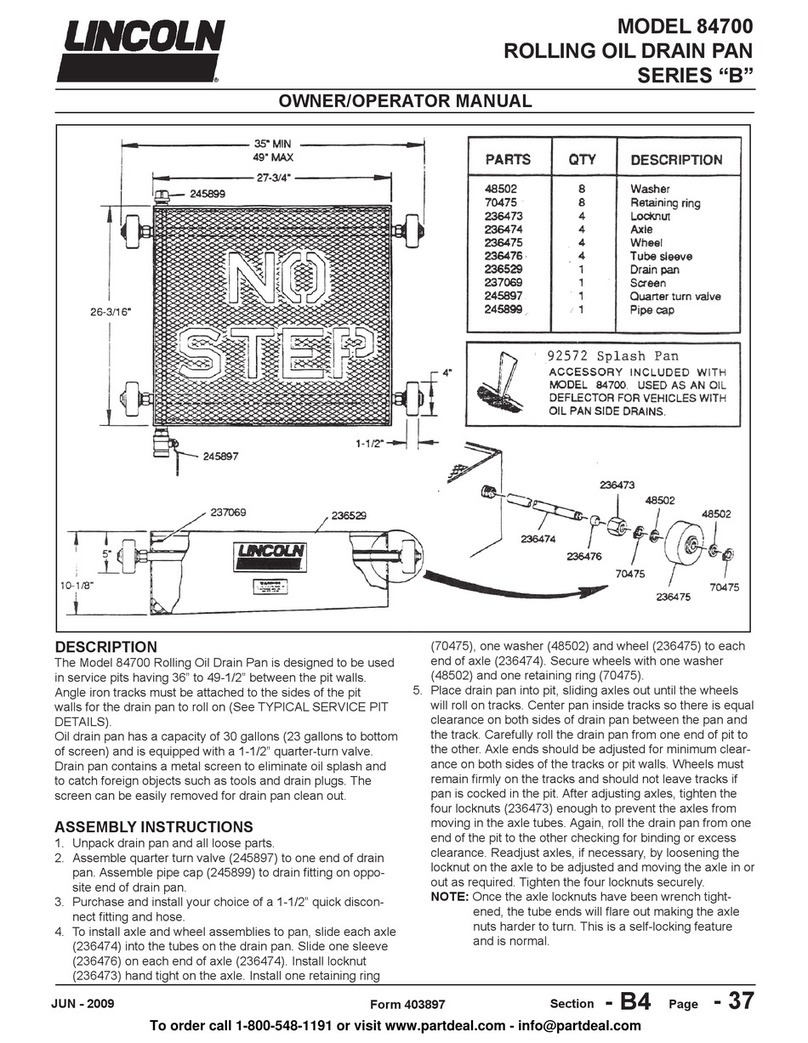
Lincoln
Lincoln 84700 Owner's manual
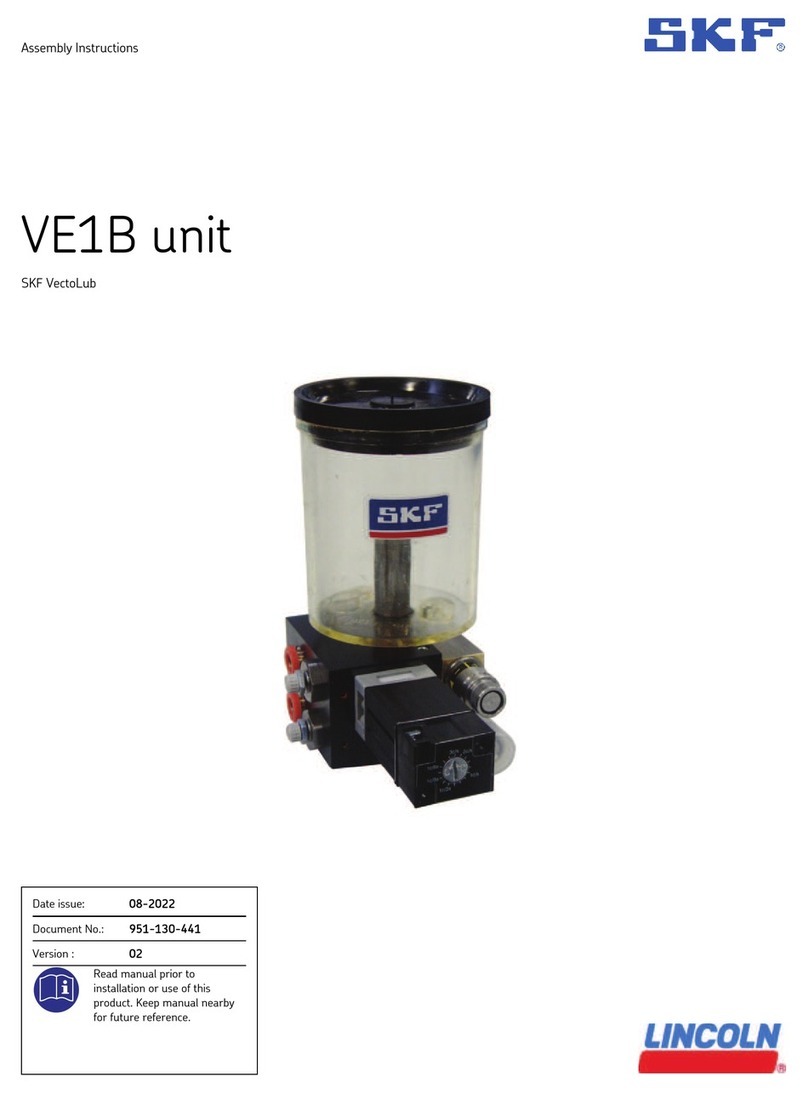
Lincoln
Lincoln SKF VectoLub VE1B unit User manual
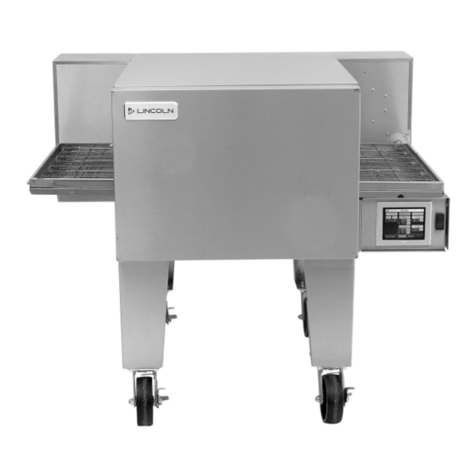
Lincoln
Lincoln Impinger Aperion 2424E User manual
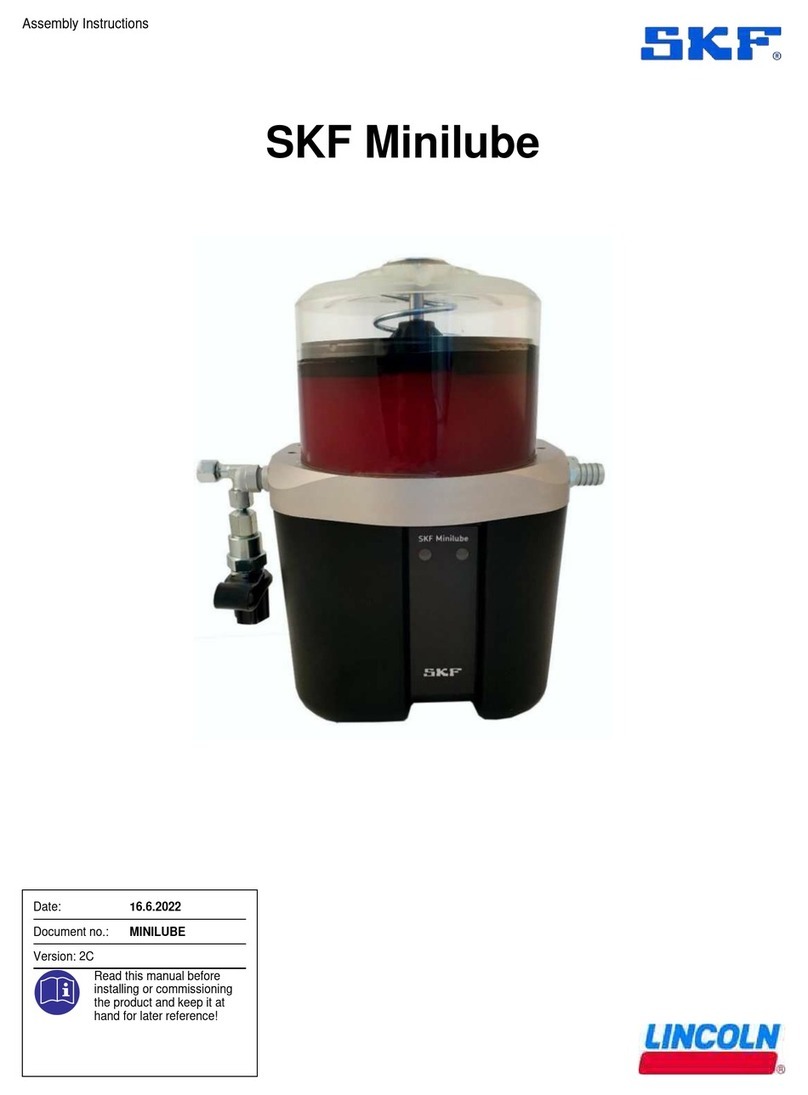
Lincoln
Lincoln SKF Minilube User manual
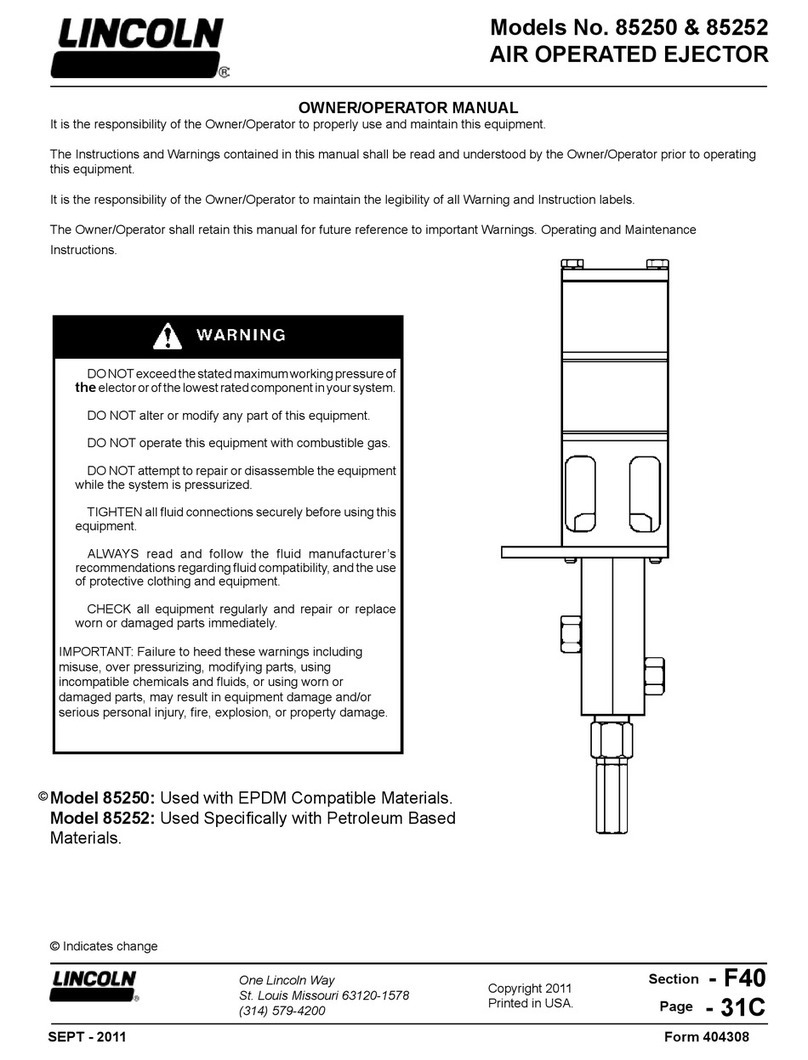
Lincoln
Lincoln 85250 Owner's manual
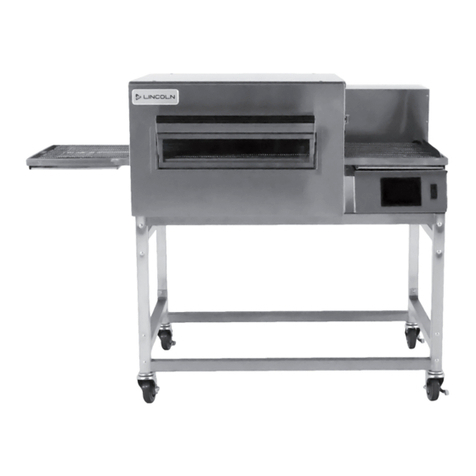
Lincoln
Lincoln Impinger 1100 Series User manual
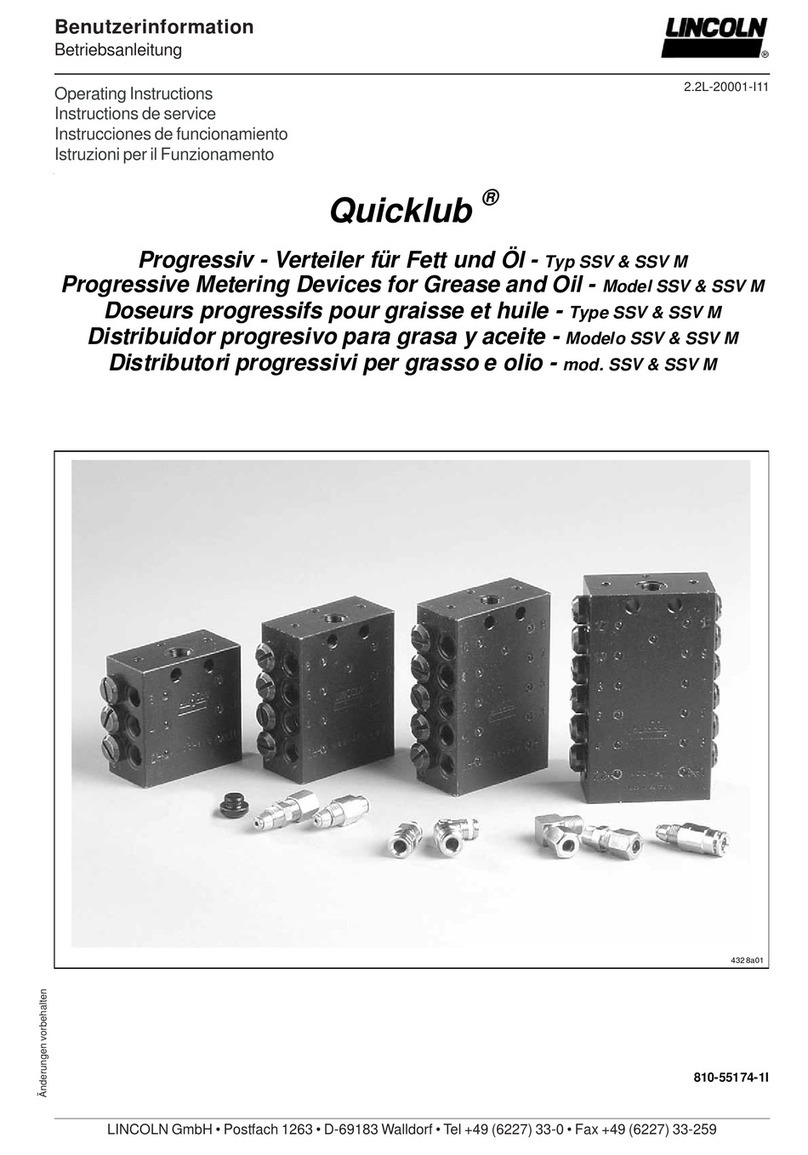
Lincoln
Lincoln Quicklub SSV User manual
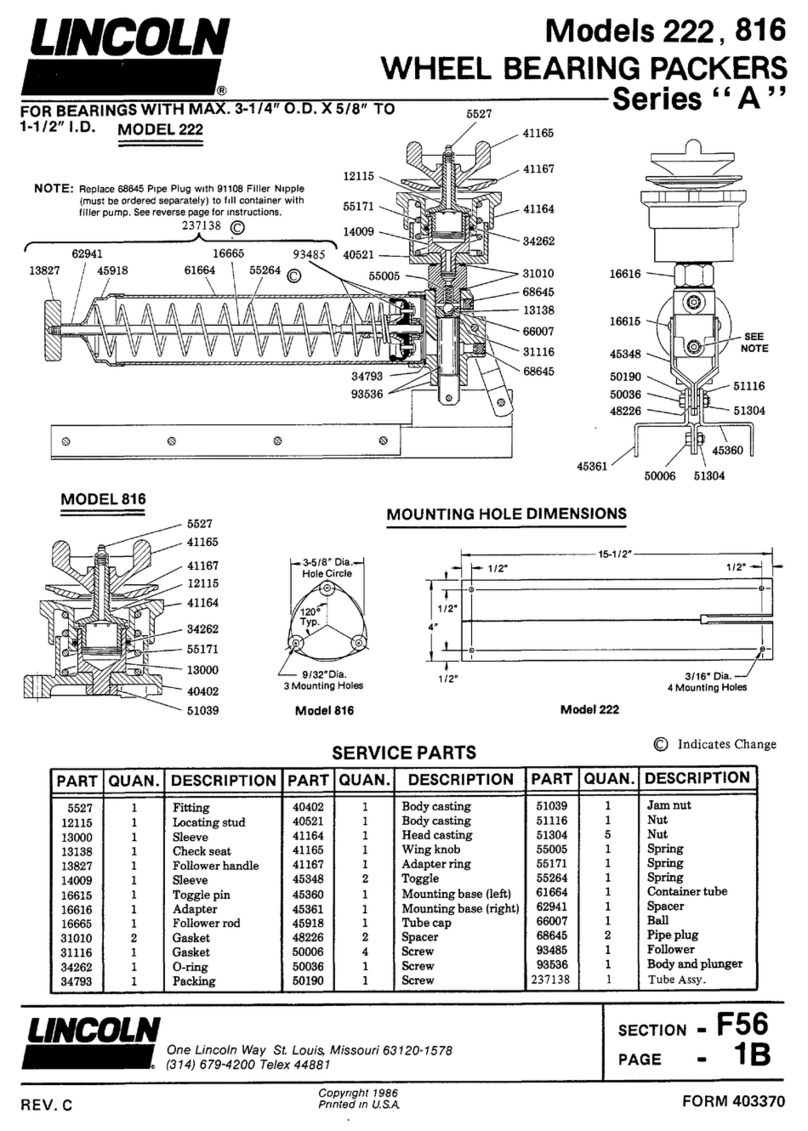
Lincoln
Lincoln A Series User manual
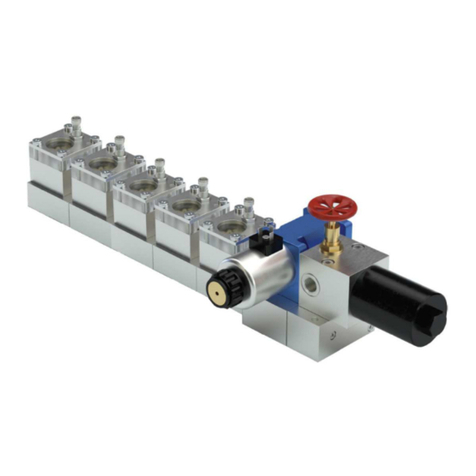
Lincoln
Lincoln SKF SMBM-X User manual
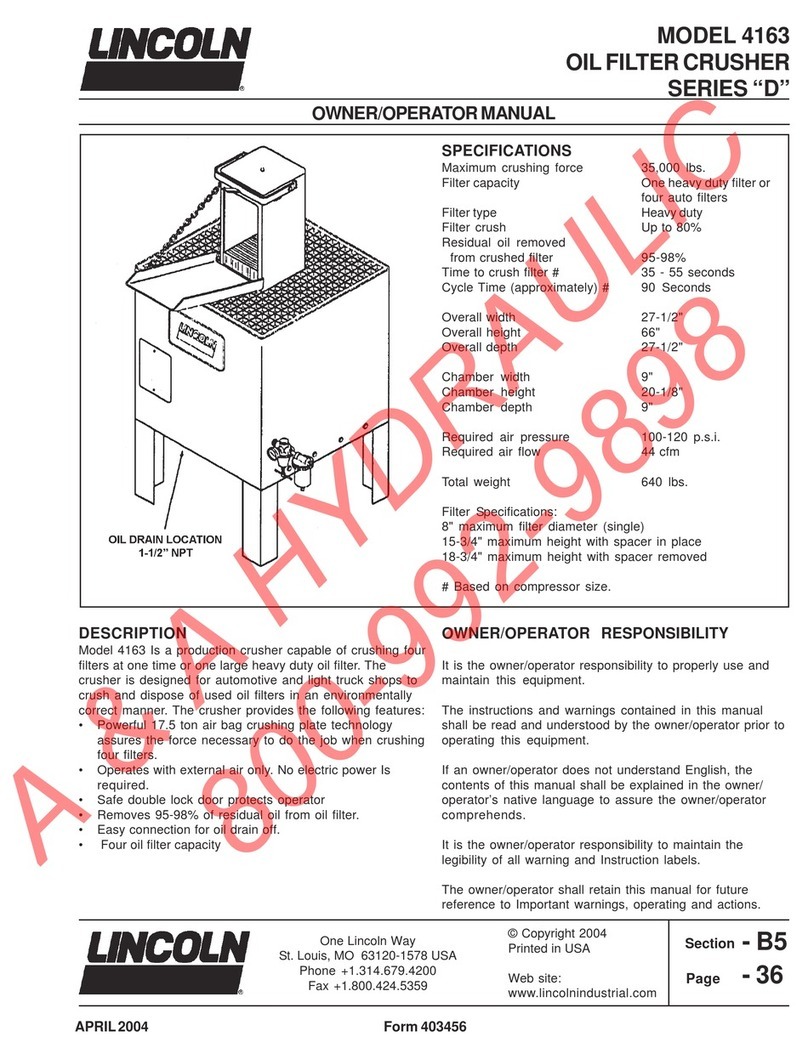
Lincoln
Lincoln D Series Owner's manual
